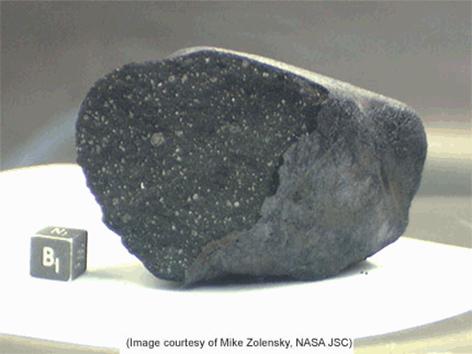Creation Corner
Panspermia? Really?

Panspermia — the idea that life is seeding itself everywhere in the universe — is suddenly popular again. The finding of the “stuff of life” in meteorites has made it popular. But panspermia assumes that those meteorites came from space and merely fell to earth.
What does panspermia mean?
Panspermia comes from the Greek adjective πας, πασα, παν (pas, pasa, pan) meaning “all” or “every,” and σπερμα (sperma), meaning “seed.” So panspermia means “seeding everywhere.”
The current issue of Time ran with the cover story, “Aliens Among Us.” Its opening is as provocative as the title:
The universe is aswarm with the stuff of biology — and it could be seeding life everywhere … and meteors that landed on Earth have been found to contain amino acids, nucleobases — which help to form DNA and RNA — and even sugars.
Seeding life everywhere. That’s panspermia.
Where did the authors of that article get that idea?
The Tagish Lake Meteorite
On January 18, 2000, a meteor fell to earth, straight toward British Canada. 97 percent of it burned up in the atmosphere. Three percent fell all the way to Tagish (TA-jis) Lake. It broke apart on the ice. The pieces of it rested there, with no chance of contamination.
Christopher D. K. Herd, PhD, and his team studied those pieces. Their report came out in June of 2011, in the journal Science. (Follow this DOI link, which should never break.) Dr. Herd’s team did find amino acids and hydrocarbons, amounting to 3 percent of the total mass of the fragments. So the only questions are:
- How did they get there?
- Where did they come from?
Dr. Herd admits that he doesn’t know. At least, that’s what his turgid turn-of-phrase amounts to. He can only speculate. His theory: the amino acids and the hydrocarbons, or the things that formed them, somehow existed in the space between stars. Once they entered our solar system, something changed them. What, he has no idea. (Note: Scientists often speak in the passive voice. You can read Dr. Herd’s prose here, at Reference 77. In this case, Dr. Herd says that he doesn’t know, and doesn’t know anyone who does know.)
A creationist speaks
Dr. Walter T. Brown runs the Center for Scientific Creation and is a Creation Science Hall of Fame inductee. Today he shared with CNAV his insight, which you can read here. His theory: the Tagish Lake Meteorite came from earth to start with. The Global Flood, with its violent release of a subcrustal ocean, launched the Tagish Meteor and millions of other comets, asteroids, and meteoroids, into space, with force enough to drive it to escape speed. Here is his evidence:
- The amino acids and hydrocarbons are the products, or the remains, of living tissue, from one or more plants, animals, or other forms of life that lived on earth. In fact the concentrations that Dr. Herd’s team report are strikingly similar to those found in the head of Comet Wild 2.
- As Dr. Herd reported, those compounds did change form, before the meteoroid hit the atmosphere. Hot enough water, at high-enough pressures, can do this. Furthermore, some of the amino acids and carbohydrates were racemized, meaning that mirror images formed (D-amino acids and L-carbs).
- Some of the compounds were dissolved in water. That probably happened before the great water jet at the Mid-Atlantic Ridge catapulted the rock into outer space.
- The meteorite fragments were rich in deuterium (hydrogen-2), carbon-13, and nitrogen-15. The great water jet caused the earth’s crust to flutter. This fluttering was violent enough to release a torrent of neutrons. Lighter isotopes of hydrogen, carbon, and nitrogen absorbed the neutrons. (That is also why comet heads turn out to be rich in deuterium, not the protium or “light hydrogen” we know.)
- The fragments contained small amounts of clay. Clay forms when water acts on rock. This can happen slowly or rapidly. Supercritical water escaping from high pressure can produce clay very quickly.
In contrast, Dr. Herd and his team had to speculate on how this neutron enrichment, the transformations, the clay formation, and so on, happened in the icy cold of space. He can’t do it, and admits it. But he makes no effort to consider an explanation that, though radical, is almost absurdly simple.
Why panspermia?
Evolutionists love panspermia because it lets them off the hook from a vexing problem: where did life come from? Francis H. Crick helped discover DNA. He knew straight away that the information in DNA did not write itself. But he could never bring himself to admit that the Genesis narrative might be correct.
So instead he embraced (and might even have invented) a theory of directed panspermia. He and Leslie H. Orgel published a six-page paper in 1972. He suggested that a long-dead alien race built and launched a brace of missiles, each laden with bacteria and blue-green algae, in all directions from their home world. One crashed on earth, and we are its by-product. Crick abandoned that theory when he realized that he couldn’t explain where that civilization came from.
Time embraces the more conventional panspermia theory. According to this, the “stuff of life” is everywhere, and the universe seeds it everywhere. Comets, asteroids, and meteoroids are all interstellar visitors.
Dr. Brown built this table showing all the evidence about comets, and how well his theory, and competing theories, explain that evidence. In fact, panspermia depends on comets coming from meteor streams or from interstellar dust and gas. But several pieces of evidence are deal-killers for one or both those theories. Among them: the richness of deuterium, which the Tagish Lake Meteorite and most comets have. Heavy hydrogen forms when water absorbs neutrons. That can happen only from an event that releases many neutrons. The tremendous earthquakes of the Global Flood likely produced that swarm of neutrons. An exploding planet between Mars and Jupiter could have produced such a swarm. But an interstellar meteor stream or dust or gas cloud could not. (The exploded planet theory has a deal-killer of its own, namely all the ice on the Moon and Mercury.)
So an interstellar origin defies logic and is well-nigh impossible. Without that, panspermia is equally impossible.
[subscribe2]
Terry A. Hurlbut has been a student of politics, philosophy, and science for more than 35 years. He is a graduate of Yale College and has served as a physician-level laboratory administrator in a 250-bed community hospital. He also is a serious student of the Bible, is conversant in its two primary original languages, and has followed the creation-science movement closely since 1993.
-

 Civilization4 days ago
Civilization4 days agoDC Pipe Bomb Arrest Raises Questions About Christopher’s Wray’s FBI
-

 Civilization5 days ago
Civilization5 days agoThe Legal Logic Behind U.S. Operations Against Narco-Terrorist Networks
-

 Executive5 days ago
Executive5 days agoNewsom’s ‘National Model’ for Homeless Wracked by Fraud
-

 Executive2 days ago
Executive2 days agoWaste of the Day: Obamacare Failed Test, Approved Fraudulent Subsidies
-

 Executive4 days ago
Executive4 days agoWhen You’re in a Hole, Stop Digging
-

 Education3 days ago
Education3 days agoWaste of the Day: Taxpayers Subsidize Football Coach Severance
-

 Civilization3 days ago
Civilization3 days agoPence Calls on Trump To Fire RFK Jr Over Abortion Drug
-

 Civilization2 days ago
Civilization2 days agoWSJ’s Fearmongering Doesn’t Survive Contact With Evidence
















[…] Reprinted from Conservative News and Views […]
Panspermia? Really? #creation #tcot #sgp link to t.co
“His theory: the Tagish Lake Meteorite came from earth to start with.”
*sigh*
Does he want to debate that? Because I’m game.
Are you sure? Last time, you backed out. Remember?
“Last time, you backed out. Remember?”
Not at all. I’m just waiting for Brown’s assurance that he won’t pass my personal details on to random strangers again.
Panspermia? Really? link to t.co
Panspermia? Really? link to t.co